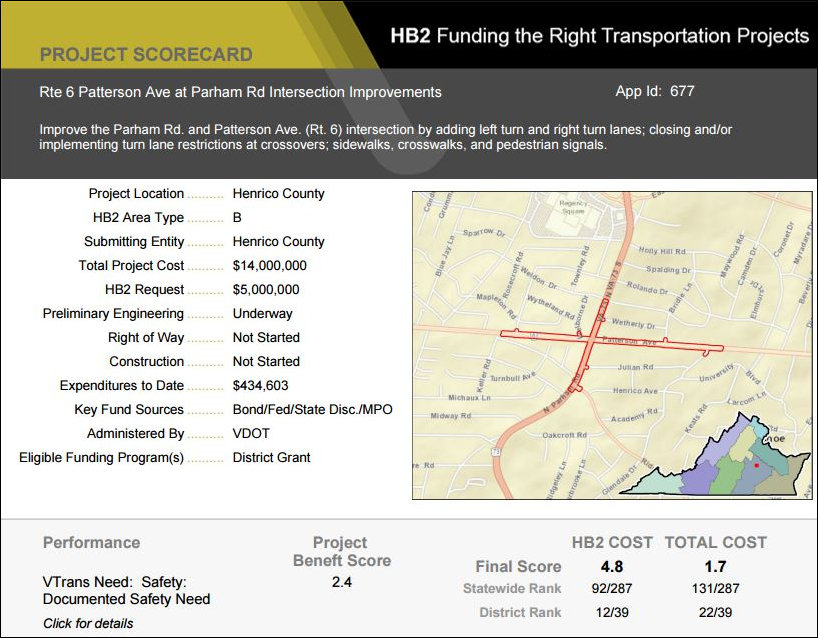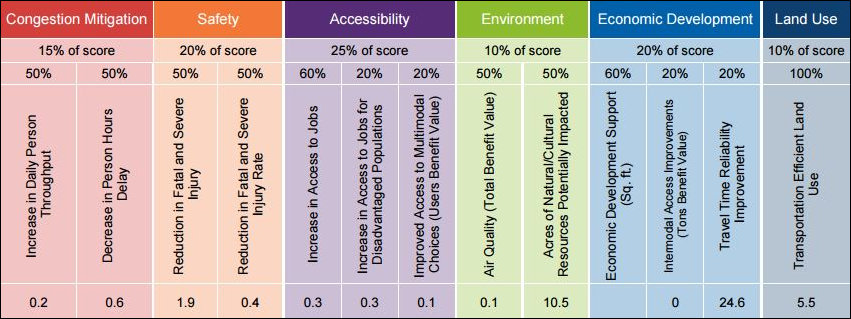by James A. Bacon
In a rare bipartisan achievement, Virginia is doing something that no other state in the union is doing: basing its transportation investments on an objective scoring system.
Earlier this month, the Commonwealth Transportation Board (CTB) approved $1.7 billion to be spent on 163 projects selected through the System for the Management and Allocation of Resources for Transportation, or SMART SCALE. The process rates projects for their impact on safety, congestion reduction, accessibility, land use, economic development and the environment.
“SMART SCALE revolutionizes the way Virginia delivers transportation,” wrote Transportation Secretary Aubrey Layne in a Richmond Times-Dispatch op-ed Sunday. “Future administrations can’t develop wish lists on a whim. Projects must be scored and vetted through the data-driven system.”
The bottom-up process starts with a consistent set of standards by which localities select projects for scoring. All nominated projects are screened and scored and funding recommendations made on the basis of the scores. The scenarios are presented to the localities and the public for a round of input. Then the CTB has the final say.
The legislation setting up the new system originated with General Assembly Republicans and was embraced by Governor Terry McAuliffe. The reform is remarkable in that the governor and powerful legislators relinquished much of their power to reward friends and punish enemies through the doling out of transportation dollars and turning it over to a process-driven system.
“No longer are we allowing politics and wish lists determine what gets built. This process is critical to moving people, jobs, and commerce, all of which is essential to building the new Virginia economy,” said McAuliffe in a press release touting the CTB vote.
“With SMART SCALE, we are promoting greater accountability, safeguarding against waste and ending the politicization that has been rampant in our transportation process for so long,” said House Speaker William J. Howell in the same press release.
Bacon’s bottom line: So, I can visit the SMART SCALE website and find a list of 287 projects along with a breakdown of their scores. There, I can see that a project about a mile from my house — $5 million to make improvements to the intersection of Patterson Avenue and Parham Road, a miserable, stinking, soul-scorching abomination of a crossroads if there ever was one — ranked 92 statewide among all projects. And I can view the scores assigned to a variety of metrics, as seen here:
That’s all well and good, but none of this is intuitive. I don’t have the faintest idea what these scores mean. Are higher scores better than lower scores? I can imagine that a major benefit of the project would be improving “travel time reliability,” as reflected in its 24.6 score. But why would “travel time delay” be so meager at 0.6? Isn’t that closely related to travel time reliability? Is the same scale being applied to each criteria? Is the scale 0 to 1, 1 to 100, or something else entirely? The explanation on how to read a scorecard doesn’t help much.
And how about the data underlying this statistics? How many car crashes and injuries occur at this intersection? How many hours of delay occur, and how is that number measured? How does one calculate the increase in access to jobs? And how does one evaluate the impact of the project on land use?
The information available to me as a member of the public doesn’t allow me to evaluate much of anything. Further, I can’t imagine being a CTB board member and finding the data any more helpful — unless they are given special training in interpreting the numbers or have VDOT staff at their beck and call to answer their questions.
While SMART SCALE undoubtedly represents an improvement over what preceded it, the state might as well be publishing its scores in hieroglyphics. Transparency is not served when the the scoring system is so indecipherable as to be unintelligible as to defeat all efforts at understanding.




